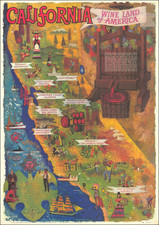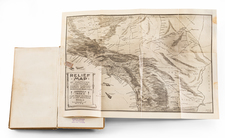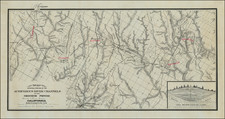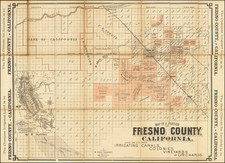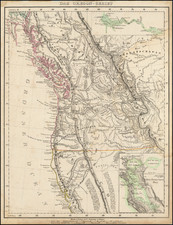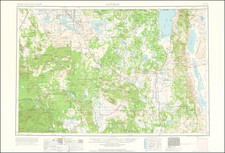Esperanza (Esparto) California -- The Promotion of an 1880s Town in Yolo County, California
Fascinating pair of maps on a single sheet, showing the Townsite for Esperanza, in Yolo County, California, as surveyed in 1887-88.
The map shows the townsite on one side, with a second map on the verso focusing on the downtown and the route of "Woodland, Capay and Clear Lake" Railroad and depot depicted, en route from Madison toward Capay.
The map was produced shortly after the Vaca Valley & Clear Lake Railroad was acquired by a subsidiary of the Southern Pacific Railroad called the Northern Railway. In the same year, the Northern Railway had been extended northwest from Madison to Capay and Rumsey. The Esperanza townsite was 3.5 miles west of Madison and the first stop on the new line.
The following article appeared in the Jun 9, 1888 edition of the Sacramento Daily Union
THE CAPAY BOOM.
THE NEW TOWN OF ESPERANZA AND ITS FUTURE.
The Projectors of the Place in Earnest — Yolo County Must Wake Up.
The Woodland Mail has the following: The promise of the new era of prosperity, so long looked for by the people of Yolo county, is found in the now developing plans and purposes of the Capay Valley Land Company. Those who have not given particular attention to the projected railroad and town building enterprises in that beautiful valley, little know upon what an elaborate scale and with what careful preparation and detail this company is working to transform it into a human bee hive. For months past, W. H. Mills, the land agent of the Southern Pacific Railroad, has given his first thought to this work. It has almost monopolized his, attention. He has at his disposal something like thirteen thousand acres of Capay valley land, along the line of the new railroad. His surveyors have blocked all this off' into twenty-acre tracts, and large lithographed maps are printing, showing the "lay of the land" admirably.
Numerous photographic views have been taken of typical scenes in the valley, and from these faithful engravings have been made, to be used in illustrating the vast amount of descriptive matter which is to be published to the world, making known the beauty and the resources of Capay valley. The visitor at Mr. Mills office will find him generally discussing the Capay valley enterprise, and the pictures, maps, etc., lying about him and in every corner of his office would lead a stranger to think that the chief business of the land department of the great railroad corporation was confined to operations in Capay valley. And there would be more than half truth in asserting this to be a fact. As Mr. Mills explained to a Woodland gentleman this week, this effort to develop Capay is the initial experiment of members of the railroad company to induce new people and new life and new ideas into Central California. And the opulent projectors of the enterprise have invested not only their money but their pride in it, and no one is foolish enough to imagine that they will begrudge any expense or effort in making their plans brilliantly successful.
Elsewhere in these columns is the advertisement or second preliminary announcement of the Capay Valley Company. It outlines briefly the idea of the first sale of Capay lands. This office is in receipt of a large litho-map showing the "Bonynge Tract," upon which is located the new town of Esperanza. The excursion to and auction sale of lots in this town will be an auspicious day, not only for Capay, but for all Yolo county. It will take place Saturday, the 23d of June. Millions of dollars of San Francisco capital will take a run up this way to sniff the country air and look the country over. "We expect," said Mr. Mills li to give hundreds of tickets away to the prominent business men and citizens of San Francisco. We are going to have the people there and we are going to sell the lots."
The map before us shows the railroad running east and west through the Bonynge tract. The town of Esperanza, containing 580 lots, lies entirely on the south side of the track. A plaza is reserved in the center of the town. Contiguous to and surrounding the town are the 61 twenty-acre fruit and garden farms, upon which the railroad proposes locating a thrifty class of people. Whether any of these small farms will be offered for sale upon the 23d depends upon contingences, but Mr. Mills intends that all these shall be in the possession of actual setters, and the homes of actual residents before Christmas.
The Bonynge tract is a beautiful piece of land, and its deep and fertile soil is easily susceptible of irrigation. A handsome two-story depot is already completed in Esperanza, and a number of other substantial improvements by private individuals have been commenced. The funding of other towns on the Barber & Steiner tract to be called Guinda, and another named Cadenasso, at Cadenasso's, will speedily follow.
The railroad people have given Yolo people a fair warning to wake up and it appears to the Mail that it is high time we did wake up. To use a little slang, we have got to get in and dance to the quickening music of progress, or as Mills says, "go beg for a permit to bury ourselves." There is no use for anybody to lay back and belly-ache about it; the railroad is going to boom Capay valley and "kickers" might just as well succumb to the inevitable first as last. We want to see the Capay Valley Land Company fill the valley so full of people that the abundance of the population will foam over and spread out over the surface of the county. Capay, Madison and Woodland need not vainly and indolently imagine that the railroad owes them anything. That the company is ready to co-operate with the enterprising citizens of Yolo county in building it up no one doubts, but that it will spend a dollar or waste a moment of time to benefit a community that won't try to benefit itself is unsafe as a betting proposition.
Esparto (Esperanza)
Vaca Valley Railroad officials gave the name Esperanza ("hope" in Spanish) to their new townsite in 1888, but when the post office was established in 1890 the name had to be changed because there was already an Esperanza in Tulare County.
The name Esparto was chosen as the new name, and it means "feather grass" (Stipa tenacissima) in Spanish. In 1888, Esparto was laid with track from the Vaca Valley Railroad (later consolidated into the Southern Pacific Railroad) that trailed to Rumsey. In 1893, Yolo County's second high school was established in the town of Esparto, Esparto High School, but a building for it was not built until 1918.
The Vaca Valley Railroad began in 1937 to remove track from Rumsey to Esparto, stopping train service northwest of Esparto in 1941. The passenger service from Esparto to Elmira was officially discontinued in 1957.
Rarity
We were unable to locate any other examples of this map.











